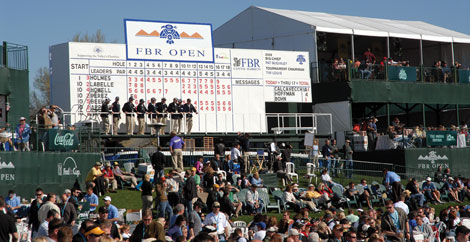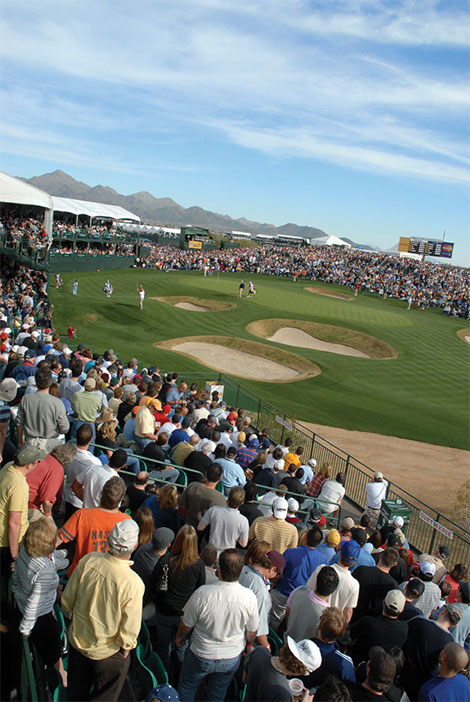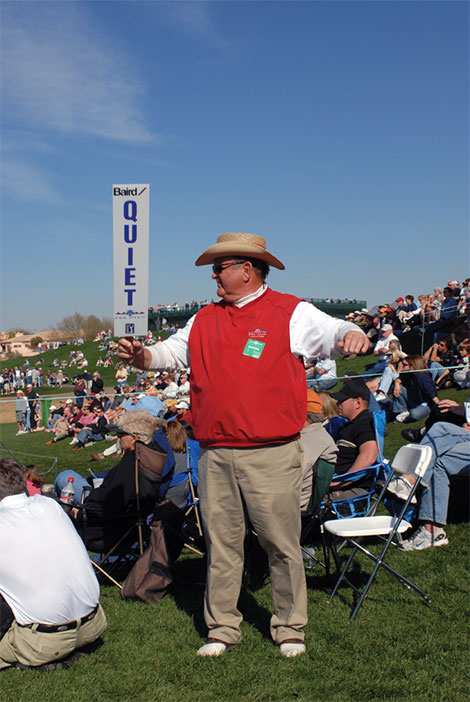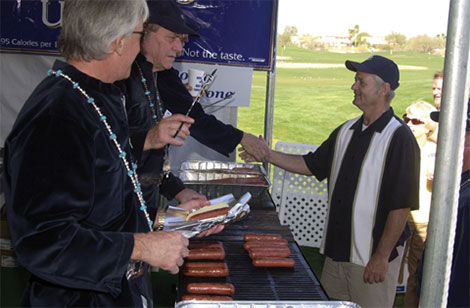We come for the golf and stay for the party, yet unbeknownst to us, there are many individuals involved in making this the greatest show on grass. Here, we observe play through the eyes and stories of the people who breathe life into the FBR Open.

The FBR Open (Phoenix Open) has evolved two-fold since its inception in 1932. Record galleries and continuous additions to the tournament grounds have helped the FBR Open, held at TPC Scottsdale, establish a league of its own on the PGA Tour. However, it’s not just the Tour pros and fans that make up the bustling scene observed live in person and on network television. Find your perfect section of sod, steal some shade and read on for tips from tournament insiders.
History in the Making
For Annie Whipple, 68, volunteering at the FBR Open runs in the family. It was Whipple’s mother, Margaret Krentz, who, in 1972 took over managing the walking scorers that followed each pairing at the Phoenix Country Club.“At that time, they scored everything on paper,” recalls Whipple, who resides in Rathdrum, Idaho and makes her way to Scottsdale each year to coordinate scorers at the tournament.

While her current pool of 100 volunteer scorers is now made up of about 60 percent men and 40 percent women, Whipple says the coed scenario wasn’t always so. “It used to be that it was all ladies that scored,” Whipple says. “The gals had to wear dresses with ribbon sashes similar to one Miss America would wear that said Phoenix Open on them. It was my mother, who in the 1980’s, talked to the Thunderbirds and got the ladies to wear slacks.”
In 2000, the tournament jumped on the tech wave sweeping the Tour, adopting the handheld scoring system on Palm devices. Whipple’s mother, who was 80 years old at the time, turned over her duties to her daughter to better manage the new technology. Already an experienced scorer in her own right, having begun scoring in 1990, Whipple now has nearly two decades of experience and has scored for some of the game’s elite including Tiger Woods, Payne Stewart, Phil Mickelson and Ben Crenshaw.
Favorite Tournament Viewing Location:
“A lot of people like number 16,” Whipple says. “As a walking scorer, walking through that tunnel to 16 and seeing all the people and the noise is just awesome.”
Quiet Please
We know them, and we know them well. While being told to stand still as you attempt to make your way toward the beer stand isn’t much fun, without the 1,100 volunteer marshals acting as crowd control, taking in all the action at the FBR Open would be far more difficult. John FitzMaurice, chairman of the marshals, says keeping everything under control stems from a hierarchy of the marshals.

“I am the chairman?I have two supervisors; one on the front nine, one on the back nine, and then there are two captains on every hole,” FitzMaurice explains. “The two captains coordinate the marshals for a specific hole.”
Approximately 400 marshals man the grounds at the FBR at any given time during the tournament week. Although a marshal’s primary role is to minimize the crowd’s effect on a player’s round, FitzMaurice notes that sometimes the opposite can’t be avoided.
“I had a marshal one year, who was spying on a fairway,” FitzMaurice says. “He couldn’t see the players [on the tee] because there was a tree in his way, so he moved out into the fairway a little bit. He put on his binoculars to see the tee and watched them hit. And I’ve always told these guys if you count to a certain number, then watch out because the ball is going to fall. So he’s looking up and decides ‘I better move.’ As soon as he does the ball lands right where he was just standing. The pro came up to him and asked ‘Did we hit you?’
The marshal said ‘No, you missed me.’
‘Did you see the ball?’ the pro questioned.
‘Yeah, the end.’
‘Well, we hollered Fore.’
The marshal said, ‘Well, I’m not only blind, I’m deaf too.’ So he no longer works the fairway, but that’s a funny story.”
Most Memorable FBR Open Moment:
Watching Phil Mickelson give a pair of Superbowl tickets to a father and son at the 2008 FBR Open.
Seasoned Pro
A veteran marshal of the FBR Open, Gene Fulks, 85, returns this year as a volunteer for the 30th time. Since beginning as a marshal at the Phoenix Country Club back in 1979, Fulks has been a mainstay long before FBR became the title sponsor.
“There was a sign-up sheet at the golf course and that is how I got started,” recalls Fulks, who now resides in Sun City. “I just really enjoy it. I still have all my pins and badges from all those years.”
As supervisor for the marshals on the back nine of the golf course, you can find Fulks patrolling in a golf cart. While his love of the game compelled him to volunteer at the tourney, a year ago, Fulks underwent a five-way heart bypass that sidelined him from playing. He hopes to return to the game as soon as possible. In the meantime, aside from his hobbies of pool and bowling on the Nintendo Wii gaming system, Fulks focuses his efforts on contributing to the smooth operation of the tournament he has enjoyed for three decades, and more to come.
“I’ll probably come back as long as I can,” Fulks says.
Favorite Tournament Viewing Location:
“At the tee box of the 13th hole, there is a great hill [where] you can see players tee off on 13 and putting out on the 12th hole,” Fulks says. “And if you walk over a little bit you can watch seven and eight near there too. It’s a wonderful place to watch the tournament from.”
Taking the Lead
As the first point of reference for golf fans arriving at the grounds, the manual leader board is a tournament staple.
“We post the scores manually because it is kind of a tradition,” says Shelly Schmucker, 38, of Scottsdale. “They have had the opportunity to make it into an electronic scoreboard, but everybody votes every year that they really enjoy having the Thunderbirds up there.”
Schmucker has been volunteering at the tourney for five years and enjoys the vantage point from high above all the hype. “We have a wonderful view; it is the best view in the house. Some of the numbers are really high and you have to stand on this ladder. Since I’m small, they put me on the ladder and the guys can roll the ladder on the wheels.”
Her outgoing personality and willingness to change scores nearly 20 feet above the scaffolding, has landed Schmucker in the limelight herself.
“I’ve made it on the front page of the sports section of the newspaper a few times.”
While seemingly removed from the commotion of the tournament grounds, Schmucker and several Life Thunderbirds sit center stage greeting incoming and outgoing fans with an update of the day’s play.
“The people who are sitting there watching 18 don’t know who is coming up the fairway, so they really rely on the scoreboard for that,” Schmucker says. “Everyone sort of stands around 18 to follow their favorites and when you change a line score and move someone up on the scoreboard, the crowd will just cheer. If it is a local favorite, they just roar.”
Favorite Tournament Viewing Location:
“I think 17 is a great place to watch from because the guys are coming off 16 and preparing for the final two-hole stretch.”
History of the Thunderdog:
Life Thunderbird, Martin Calfee, 72, shares a little bit of the Thunderdog hotdog’s history and how it has become a fixture between the 10th green and the practice tee at TPC Scottsdale during the tournament week.

Do you cook Thunderdogs yourself during the week of the tournament?
Oh, yes. I’ve been doing this for 11 years.
What is your tournament schedule like?
I go out there on Wednesday morning of the Pro-Am and I stay until Sunday afternoon. I start setting up at 7:30 a.m. every morning and get out of there about 5 o’clock, then I come home and I crash.
What is the secret to a great Thunderdog?
The love that goes into one of those little fellers. Years ago, one of my first years out there, the dogs came frozen and I had to thaw them because I couldn’t put them on the grill frozen. So to thaw them, we boiled them in water and somebody poured some beer in there. Someone tried it and said how good they were; I tasted it and agreed. From then on that’s how we prepare them before we grill them.
What kind of beer do you boil the dogs in?
Oh, that is a secret. I couldn’t tell you what the brand of beer was. That’s what makes them special.
How many Thunderdogs are stocked in preparation for the tournament?
We order 4,500 and I cook every one of them individually.
Is there a particular day when the dogs just fly off the grill?
Saturday is our biggest day and we probably sell 1,200 on that day.
Does anyone help with the cooking?
Oh, yeah. I have about 15 Thunderbird volunteers out there but I stay right there the whole time.
What keeps you coming back?
The whole key to it really is that all the proceeds go to charity. I raised about $60,000 for charity out of that whole stand last year.
Do you have a favorite Thunderdog story?
Yes. We were closed one day about three or four years ago because it was raining. The tournament was still on but the wind was blowing and I just didn’t want to open the stand up that day. Some random kids went out there and just opened up the stand, turned the grill on and started selling hotdogs and booze. They had it open for about an hour until they got caught. It was unbelievable, I couldn’t believe it.